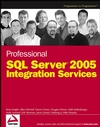I received a copy of Professional SQL Server 2005 Integration Services
a few weeks back from Kathi. Because of illness and a few things going
on around home, I've not gotten around to writing a full review of the book
yet, though I'm dilligently working towards that goal. However, I've
looked at enough of the book to give my first impressions.
First and foremost, I love the tutorial nature of the book. An area of
SSIS is covered, explaining what it is and what it's used for,
and immediately following that is an exercise to reinforce the
concepts. For instance, chapter 4 talks about a For Loop Container.
Then there's an exercise to use a For Loop container with a simple
script to show how it works. This is a very useful technique to help
someone learn the technology. Don't get me wrong, I love many of the
O'Reilly books I have in my library, the majority of those not being
tutorial in nature. Those books present the knowledge and often give a
simple example or two, usually with code snippets. And I can learn from
those kinds of books. However, if I want to help someone learn the
subjects, I've got to find a book that's more tutorial in nature. Pro
SSIS is like that. It's a book I could hand to a developer to work
through and they'd come away with a good working knowledge of SSIS,
even if the developer didn't previously have a good background on
related technologies, like SQL Server 2000 DTS.
Second, this book is definitely in the format of the Wrox books of old.
In other words, it conveys the information in the most straight-forward
typeface and layout possible. That's one of the things I like about
Wrox books. I'm not having to fight with watermarks to try and read
text. Nor am I fighting with sidebar upon sidebar upon sidebar to try
and stay with the main flow of each chapter.
Finally, I like how there are useful examples sprinkled throughout that
aren't entirely germaine to SQL Server, but when it's appropriate. For
instance, when the WMI Data Reader is discussed, an example of hitting
the Windows event logs is presented, as is another example on getting
the free space available on disk. These aren't core SQL Server, but
they do represent areas where a SQL Server DBA who has any
responsibilities with respect to the operating system would be
interested. For someone like me, who sits more on the OS side now,
these little nuggets of information thrown in make the book more
interesting.
With that said, I'll post to the blog when I've completed the review.
Overall, however, based on what I've read, it's certainly a book I'd
recommend to folks interested in SSIS.



